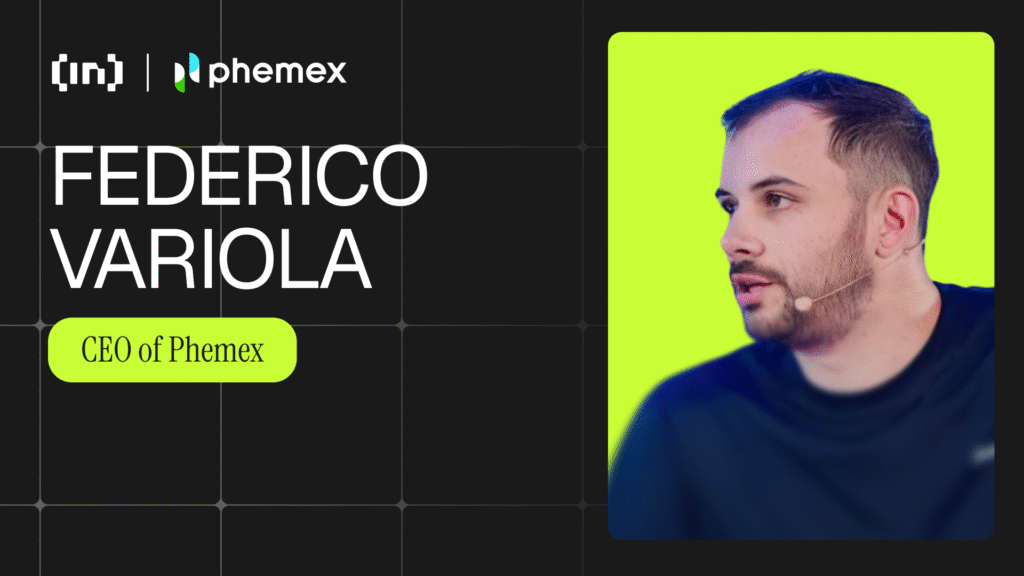Volatility Isn’t The Enemy: Inefficiency Is

By Federico Variola, CEO of Phemex
October 10, 2025, will be remembered as the day crypto markets experienced their largest liquidation event in history. Over $19 billion in positions evaporated within 24 hours. More than 1.6 million traders watched helplessly as their accounts were forcibly closed. President Trump’s announcement of 100% tariffs on Chinese imports triggered a cascade that nobody saw coming, but the scale of destruction that followed wasn’t just about geopolitics.
As CEO of Phemex, I spent that day ensuring our traders could manage their positions during the crisis. I remember the moment the alerts started hitting my phone: $HYPE dropping to $25, $PEPE down 75%. My first thought was that we had a liquidity issue on our platform. I opened CoinGecko and saw those same prices across all exchanges.
While our systems held, I watched competitors’ platforms fail their users at the worst possible moment. What I witnessed wasn’t a technology problem. It was a leadership problem.
When Infrastructure Fails, Leaders Are Responsible
In the immediate aftermath, the pattern was everywhere: failed log-ins preventing account access, failed stop-loss order execution, flash crashes where altcoins briefly touched zero before recovering. I saw disciplined traders lose everything because their exchange couldn’t execute their orders.
The lack of liquidity across all exchanges hit even platforms operating smoothly. Exchanges like ours, with slippage protection in place, or Hyperliquid with auto-deleveraging, still faced the impact. When liquidity evaporates market-wide, no platform is immune.
During extreme volatility, milliseconds matter. Traders with risk management should be protected when markets turn violent. But risk management only works if the infrastructure performs. When platforms fail, strategy doesn’t matter.
The majority of liquidations on October 10 hit over-leveraged long positions built during Bitcoin’s rally above $125,000 earlier that week. While 85-95% of liquidations result from trader decisions, platform failures multiply the damage. When exchanges go down, protective orders don’t execute. Manageable losses become catastrophic wipeouts. And traders who trusted us with their capital pay the price for our infrastructure decisions.
Every trader who couldn’t access their account on October 10 represents a leadership failure. Not their leadership: ours.
The Infrastructure Investment No One Sees
October 10 revealed which exchange CEOs had made the hard choice to invest in resilience, and which had simply scaled for growth.
I’m proud of Phemex’s infrastructure decisions. Our systems processed orders normally throughout the event. No widespread outages. No mass execution failures. Our traders maintained access to their accounts and risk management tools throughout the crisis.
Reliability doesn’t come cheap.
When building Phemex, I over-invested in infrastructure. When a trader’s livelihood is on the line, uptime isn’t negotiable. We built:
Robust, scalable infrastructure designed to handle surges far beyond our peak volumes. When order flow spikes 10x in an hour, systems hold or fail.
Real-time risk controls that function under stress. Circuit breakers and position monitoring can’t have blind spots during critical moments.
Redundant systems that eliminate single points of failure. Geographic distribution, backup matching engines, automated failover protocols. Every system has a backup, and every backup has been tested.
Continuous stress testing that simulates scenarios worse than October 10. We don’t wait for real crises to discover our limits.
These principles are embedded throughout our platform: from advanced order types to capital efficiency features to core infrastructure. Throughout 2025’s volatility cycles, Phemex maintained 99.9% uptime. During September’s market turbulence, when other platforms struggled, our traders continued executing strategies without interruption.
After October 10, we immediately published comprehensive guidance to help traders understand what happened and position for what comes next. Beyond that, we established a recovery fund and offered bonuses to help mitigate losses for affected traders. Not because our platform failed, but because we believe in supporting our community during crisis.
What Traders Need to Know
Here’s what I tell traders about surviving volatility.
I’ve learned this through years of market crises: traders who survive are prepared, not lucky. And they choose their platforms carefully.
Set partial stop-losses at multiple levels. Instead of one stop-loss order for your entire position, consider setting multiple partial stop-loss orders at different price points. For example, if you’re long with a position of 10 BTC, you might set a stop-loss for 3 BTC at one level, another 3 BTC at a lower level, and keep 4 BTC for manual management. This creates layers of protection as the market moves against you. Note: take-profit and stop-loss orders on most platforms apply to the current order only, so you’ll need to structure your position with this in mind.
Understand when isolated margin is safer. While Phemex’s cross-margin mode can provide flexibility in normal conditions, extreme events like October 10 showed that isolated margin would have protected most traders better. Cross-margin allows losses in one position to drain your entire account balance, while isolated margin limits your risk to the margin allocated to that specific position. In circumstances like October 10, having positions in isolated mode would have prevented total account wipeouts for many traders.
Size for extremes, not averages. Markets that can rise 50% in weeks can also fall 15% in hours. The traders who survived October 10 had sized their leverage for 20% swings, not 5%.
Choose reliability over marketing. Risk management means nothing if orders don’t execute. An exchange isn’t just about fees or features. It’s about whether the infrastructure performs when prices move violently.
The industry has failed to be transparent about platform reliability. Volatility doesn’t punish everyone equally: it punishes the unprepared. But preparation includes choosing a platform that won’t fail you in a crisis.
A Challenge to My Fellow CEOs
Let me be direct: the crypto industry’s infrastructure crisis won’t fix itself.
For too long, we’ve competed on the wrong metrics. Trading fees. Token listings. Marketing budgets. October 10 exposed the truth: operational resilience is what separates professionals from amateurs.
Low fees are worthless if orders don’t execute. Deep liquidity means nothing if traders can’t access it during volatility. Trading tools are useless if the platform crashes when prices move.
Here’s what concerns me: I fear too many exchanges will learn the wrong lesson from October 10. They’ll offer compensation to affected users, issue statements about “unprecedented market conditions,” and return to business as usual once the headlines fade.
That’s not leadership. That’s damage control.
I’m calling on my fellow exchange CEOs to join me in a different approach: transparency and accountability.
Publish your uptime statistics. Transparently and continuously.
Share your stress test results. Show traders your systems can handle 10x volume spikes, not just average conditions.
Invest in infrastructure now. If you’re not ready today, you won’t be ready when it matters.
Accept responsibility when you fail. Compensation programs are necessary when platforms fail, but preventing those failures should be our primary obligation.
Operate transparently as an A-book exchange. Show traders that you’re not betting against them. When exchanges operate as B-book operations (taking the opposite side of customer trades), there’s an inherent conflict of interest. A-book exchanges route orders to the market, aligning the exchange’s interests with traders’ success.
Interestingly, decentralized protocols like Aave, Uniswap, and Hyperliquid processed enormous liquidation volumes on October 10 without significant operational disruptions. If DeFi can achieve this level of resilience, centralized exchanges have no excuse.
At Phemex, we view infrastructure as our competitive advantage, not a cost center. Stress testing is continuous, not quarterly. We design redundancy into every system from the start. This is the standard every exchange should meet.
What Comes Next
Opportunity follows crisis.
History repeats. The May 2021 crash preceded a multi-month rally. The March 2020 collapse set up the 2020-2021 bull run. Major crashes clear leverage and create opportunities.
My prediction: the next crisis will be worse if exchanges don’t change course.
Volatility creates mispricing. Liquidation cascades shake out weak hands. Markets that crash 12% in an hour can bounce back just as fast. But only if your platform works.
Smart strategy beats market timing. Those who thrive aren’t the ones who predict every move. They’re the ones who prepare for uncertainty and execute when opportunity emerges. That requires infrastructure that works.
The difference between profit and ruin is whether your exchange works.
Moving Forward
At Phemex, we’re building infrastructure that works when markets turn violent. We’re investing in systems that can handle tomorrow’s extremes. Today’s extreme becomes tomorrow’s normal.
I’m committed to uptime as a fundamental obligation, not a marketing metric.
Tariffs, regulatory changes, geopolitical events, and market dynamics will continue creating massive price swings. Traders can’t control these forces. But they can control their preparation, their risk management, and their choice of platform.
Volatility is inevitable. Inefficiency is a choice.
The October 10 liquidation proved which platforms had made the right choice. As crypto continues maturing toward institutional adoption, that distinction will only grow more important. The exchanges that survive and thrive won’t be those with the flashiest features or the cheapest fees. They’ll be the ones traders can trust during extreme conditions.
To traders: volatility will return. Choose a platform built to handle it.
To my fellow CEOs: the industry is watching. October 10 was our stress test. Some of us passed. Others failed publicly. What you do next will determine whether you lead or fail.
I know what Phemex will do: we’ll keep building infrastructure that works. That’s not a marketing slogan. It’s a commitment from me, personally, to every trader on our platform.
The future belongs to leaders who put traders first.













